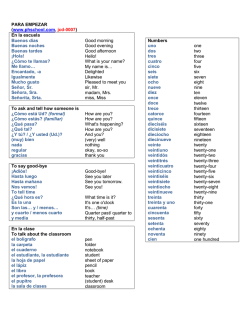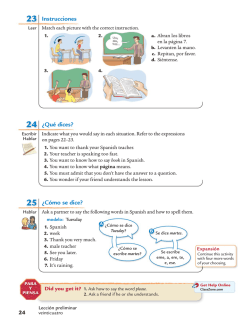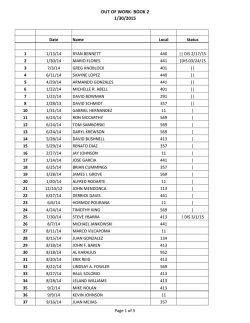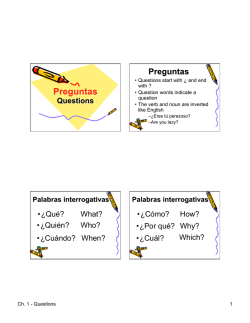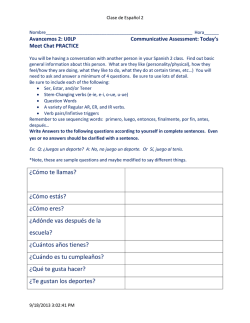
Back to School Bootcamp
2 Spanish Back to School Boot camp Review & Practice 1. Classroom Survival Phrases 2. Name Games - Alphabet & Spanish sound system review and conversational practice 3. Say What? Question Words Review 4. School Supplies Review www.foreignlanguagehouse.com copyright 2015 3 Nombre: The Top 10 Spanish Classroom Phrases Here are some basic, but necessary Spanish phrases. ALWAYS say these in Spanish The Top 10 1. Yo comprendo. 1. I understand. 2. Repita por favor. 2. Repeat please 3. Más despacio por favor. 4. ¿Cómo? 3. Slower please. 4. How was that? Huh? 5. No comprendo. 5. I don’t understand 6. ¿Puedo ir al baño? 6. Can I go to the bathroom? 7. ¿Cómo se dice . . . en español? 8. Tengo una pregunta. 9. ¿Qué significa . . . en inglés? 10.¿Puedo hablar inglés? 7. How do you say . . . in Spanish? 8. I have a question. 9. What does . . . mean in English 10. Can I speak English? Nombre: www.foreignlanguagehouse.com copyright 2015 4 Actividades For Partners & Groups 1. Name it. Nómbralo. One partner touches a Spanish phrase. The other partner needs to read it out loud in Spanish. Take turns. 2. Next, do the same as above but the speaker needs to say the English meaning. 3. Emparejar. Matching. Cut out each phrase and shuffle them. Now match the correct meanings together. 4. Lotería. Bingo. Tic Tac Toe. Create game boards with the cut out phrases to play. Can you think of any new games to help you learn? 5. Pégalo. Hit It. Place all of the phrases on a table. Play pégalo with three other people. Your teacher or the “caller” of the group says a survival phrase’s English meaning. The first person in the group to touch or hit the correct Spanish phrase wins the point. www.foreignlanguagehouse.com copyright 2015 5 Name: More Practice: Real Life Situa ti ons Which Survival Phrase Would You Use? Write down the correct Useful Phrase. 1. Your teacher is speaking very quickly. Ask her to slow down. 2. You want to know how to say the word “backpack” in Spanish. 3. Your teacher asks the class, ¿Comprenden? (Do you all understand?) and you do! 4. Even though you wish you could wait until class is over, you NEED to go to the bathroom! 5. You ran out of paper and you need to ask a classmate to borrow a sheet. 6. You raised your hand, but then you forgot what you wanted to say. 7. Your teacher asks you a question, but you do not know the answer. 8. Your teacher keeps saying the word, tarea. Ask what it means in English. 9. You want to know how to spell buenos días. 10. You are taking a Spanish quiz. How do you pledge your honor 11. You have a question during Spanish class. You have tried EVERYTHING . . . No comprendo. Tengo una pregunta. ¿Qué significa . . . en inglés? You have even tried to ACT OUT your question. Your teacher still does not understand what you want to know. As a last resort, you decide to ask permission to speak English. www.foreignlanguagehouse.com copyright 2015 El Alfabeto a b c ch d e f g h i j k l ll n ñ o p q s t u v r rr w x y z Some extra letter sounds ! ch- just like English ch, ll- y sound, ñ= nyah, r = erre, the tongue-rolling r Pronunciation Practice A - E - I - O - U el burro sabe más que tú. A - E - I - O - U the donkey knows more than you. Las Vocales - the Vowels A, E, I, O, U Spanish Vowel Sounds Spanish vowels have deeper longer sounds than our short vowels in English. A (Ah) E (EH)! I (EEH)! O(OH) U (OOH) Spanish Pronunciation Practice Here is a rhyme for vowels practice: A, E, I, O, U El burro sabe más que tú. Trabalenguas or Tongue Twisters. S-S-S-S-S AZUL. (The English z sound doesn’t exist in Spanish.) La cebra corre arriba en la sierra. (role those r’s for rr.) Yo como panqueques de queso en Albuquerque. (que = hard K sound) El arbolito de Perú. Los zapatos azules son de Zacatecas. PODCAST: http://speakspanisheveryday.com/wp-content/uploads/2010/07/SpanishVowels-Basics.m4a www.foreignlanguagehouse.com Copyright 2010 images by classroomclipart.com & clipart.com Name Tags Choose one half of the name tag and write your Spanish name on it. Cut it out and fold it over. Nombres * Names 1. Choose a Spanish name from the list on line. Go to http://homepage.ntu.edu.tw/~luisa/ gramatica_espanola/nombres_espanoles.htm This will be your new identity in Spanish class! 2. Practice spelling your name out loud using the Spanish alphabet. Write it in one of the squares of the bingo grid below. 3. Walk around the classroom and ask your classmates their name: ¿Cómo te llamas? 4. When someone asks you the question, answer: Me llamo. . . + your new Spanish name 5. After you exchange names, ask how to spell it: ¿Cómo se escribe tu nombre? 6. Write your classmateʼs name in one of the squares of the bingo grid. 7. Your teacher will spell names of people in your class. If you hear a name you wrote, draw an X through the square on your grid. 4 Xʼs in a row is a Bingo. Shout ¡LOTERIA! www.foreignlanguagehouse.com copyright 2012 ¿Cómo te llamas? * What is your name " Saying your name in Spanish is the most important skill here, but knowing how to spell it aloud is also useful and it give you pronunciation practice. Ask _______ classmates ¿Cómo te llamas?, or What is your name? Then ask each person ¿Cómo se escribe? or How do you spell it? ¿Cómo te llamas? ¿Cómo se escribe? 1 2 3 4 5 6 7 8 9 10 ***Your teacher may give you time limit to see how quickly you can do it. Más Actividades Cadena. Chain. Get in to large groups and get in to a circle. Stand or sit. The first person says his Spanish name. The second says the name of Person #1, then his. The third then says the first two Spanish name and then his own. Cadena is an add-on game; see how far your circle of students can get. Teléfono. Telephone. Stand or sit in a circle. Your group starts with one person whispering 2 or more of the Spanish names in the group into his neighbors ear. This person then repeats exactly what he heard in a whisper to his neighbor. See if the end of the circle has the Spanish names right¡ How to Ask and Answer Questions in Spanish Spanish Question Words Important “survival expressions” include the question words. Imagine everything a reporter may ask: WHO, WHAT, WHERE, WHEN, HOW, WHY? You will hear these words frequently in class. Who = Quién What = Qué When = Cuándo Where = Dónde Why= Por qué How = Cómo How much/how many = ¿Cuánto(os)? What is it? = ¿Qué es esto? 1. Sing a Song. You can remember the question words by singing them as a song. Do you recognize the tune? Itʼs “Row, Row, Row Your Boat”! Quién, Qué, Cuándo, Dónde, Por qué y Cómo Cuánto, ¿Qué es esto? ¡Las Preguntas! 2. Singing Contests. Get in to groups or with a partner. Who can sing the loudest, fastest, best, with a silly voice. 3. Creating Questions. To change any statement to a yes/no question, switch the verb—bailas, habla—in front of the subject, and donʼt forget BOTH SETS OF QUESTION MARKS. Statement ! ! ! ! ! ! Question Tú bailas." " Él habla inglés." " " " " " " " " ¿Bailas tú? ¿Habla él inglés Mixed Up Table Match Up www.foreignlanguagehouse.com copyright 2012 Question Word Drills The first! set of The columns arebelow Mixed does the notSpanish go withmeaning A across from Writethe theEnglish correct letter next columns doUp, not#1 match; does notit.match meaning. You and a to its Spanish question word. partner need to match up the Spanish question word with its English meaning. Your teacher will show you how to do this using numbers or letters. Spanish Question Word English Question Word 1. Quién A. Where 2. Qué B. How 3. Cuándo C. Who 4. Dónde D. What is this? 5. Por qué E. Why 6. Cómo F. How many? 7. Cuánto G. When 8. ¿Qué es esto? H. What See how fast you can write the English meaning in the column to the right of the Spanish question word! Spanish Question Word English Question Word 1. Quién 2. Qué 3. Cuándo 4. Dónde 5. Por qué 6. Cómo 7. Cuántos? 8. ¿Qué es esto? Now, can you write the Spanish question word in the column to the right of the English word? English Question Word Spanish 1. Who 2. What 3. When 4. Where 5. Why 6. How 7. How many? 8. What is this? SMALL GROUP BINGO www.foreignlanguagehouse.com copyright 2012 THE POINT: Listening comprehension, memory, & recognition Materials: TL content or pictures or symbols or numbers, Bingo boards or tables: student created by folding up notebook paper, or teacher created on handouts, pencils with erasers to write check marks on squares, markers: beans, buttons, etc. 1. Each student has a bingo table or board that has the TL content in different squares. 2. Each student has a pencil or markers. 3. Teacher or leader calls out or describes TL content. 4. Students are to mark the appropriate square. 5. The first student with the designated amount in a consecutive row wins. 6. The winner must say the TL answers on each square correctly to receive points or a prize. I Have It! THE POINT: Listening comprehension & practice saying lo tengo. Materials: identical set of flash-cards for each student. Students can make their own. 1. Students create, & then arrange their vocabulary picture cards, verb conjugation cards, etc. face up on their desks. 2. Teacher calls out vocabulary, conjugations, fill in the blank sentences or descriptions, and even questions or answers. Visuals can also be shown to class as prompts for answers. 3. The first student to hold up the correct card and call out I have it or Yo lo tengo, or Je lʼai wins a point individually, or for the team. Hit it! THE POINT: TL recall, pronunciation, and speaking Materials: One set of picture flash cards for each group 1. Arrange students into small group circles on the floor. 2. Each group arranges their set of picture flash-cards in the middle of the circle. 3. The teacher calls out a word, phrase, or description. The first student to tap or hit the correct card wins the point and takes the card. 4. The player with the most cards at the end of the game wins. Concentration or Memory Concentration THE POINT: Vocabulary recognition & TL reading Materials: picture flash cards with matching TL word flash cards 1. Place all of the cards face-down,and take turns flipping over two cards at a time. 2. Orally identify every picture or word that is turned over. 3. If you find a match,you may take another turn 4. If you do not find a match,continue with the next player. 5. When all of the matches have been found,the player with the most pairs wins. Trading Cards THE POINT: TL descriptions while conversing MATERIALS: Picture flash cards, one for each student. Duplicates are okay if the class is large. 1. Give every student a picture flash-card. 2. Students circulate around the room, asking classmates to identify or describe their picture. 3. Aftereachinteraction,studentsexchangecardsandmoveontoanewperson. 4. Continue until time is called. Path of Pictures THE POINT: Vocabulary recognition & speaking MATERIALS: A group or class set of visuals, A timer 1. A path of pictures is created with the visuals on the floor of the classroom. 2. ONE STUDENT AT A TIME walks the path of pictures. He or she must say the target language word or a description of each picture. 3. The player who completes the path with correct TL descriptions, or the one who goes the farthest wins. Q u e s t i o n W o r d T i c Ta c To e TicQ uTac Toe estio n W oInterrogativas r d T i c Ta c To e Classmate Survey Classmate Survey Ask 8 different people what the question word means. After they answer correctly in English they need to write th Ask 8 different people what the question word means. After they answer correctly in English they need to write their initials on the square. the square. Play tictac tac toe other games with a partner. Play tic toe andand other games with a partner. Partner A says the Spanish question word and its English meaning before markingbefore X or O. marking Then Partner B goes. Partner A says the Spanish question word and its English meaning X or O. Then Partner B goes. Cut out the Squares to play the games on the next page. Cut out the Squares to play the games on the next page. Quién Quién Por qué Cuándo Cuándo Cómo Por qué ¿Qué es Dónde Cuánto Cómo Espacio LIbre Free Space esto? ¿Qué es Dónde (os)Cuánto Qué Espacio LIbre Free Space esto? www.foreignlanguagehouse.com copyright 2012 (os) Qué Nombre:_____________________________ Los Materiales Escolares - School Supplies 1. The book bag - backpack -La mochila 2. la carpeta - the binder 3. The pencil -El lápiz 4. The pen - El bolígrafo/ la pluma 5. la goma - the eraser 6. la regla - the ruler 7. The scissors - Las tijeras 8. The crayons - Los crayones 9. The book - El libro 10. A sheet of paper - Una hoja de papel 11. The homework - La tarea Unas partes del salón de clase 1. The teacher - La profesora /el profesor 9. The laptop - el laptop, el portátil 2. The student - El alumno/ la alumna 10. The tablet - la tableta 3. The classroom - El salón de clase 11. Lunch - el almuerzo 4. The door -La puerta 12. Recess/ break - El recreo 5. The window - La ventana 6. The whiteboard - El pizarrón 7. The eraser (for the board) - El borrador 8. The computer - La computadora Nombre: __________________ Los materiales escolares You will read an action series and a story about a student & school supplies-¡completamente en español! I. Matching. Match the school supply with its English meaning. **Write the letter in the space next to the number 1. un libro 2. unos lápices A. some scissors B. some markers C. a calculator 3. una carpeta 4. un bolígrafo D. some pencils E. a book F. an eraser 5. unos marcadores 6. una calculadora 7. unas tijeras 8. una goma G. a pen H. a binder Action Series. Read the simple, logical set of sentences below several ways: listening to the teacher read it, silently, out loud to a partner, or with your class out loud. 1. Yo necesito unos materiales escolares. 2. Yo voy la papelería con mi amigo 3. Yo miro unos materiales escolares. 4. Yo busco unas carpetas, unos lápices, y unos bolígrafos en la papelería. 5. Yo compro los materiales escolares con efectivo. 6. Después de comprar, Yo voy al café con mi amigo. Fill in the blanks below with the correct verbs according to the Action Series above. 1. Yo ____________ unos materiales escolares. 2. Yo ___________ la papelería con mi amigo 3. Yo ____________ unos materiales escolares. 4. Yo ____________ unas carpetas, unos lápices, y unos bolígrafos en la papelería. 5. Yo _____________ los materiales escolares con efectivo. 6. Después de comprar, Yo __________ al café con mi amigo. **Extensión Activities: Change the first pronoun, YO, to another subject pronoun such as tú, él, ella, usted, nosotros, ellos, ellas, or ustedes. Then change the verb conjugations. Nombre: _________________ Juan Pablo y los materiales escolares Learn these verbs from your teacher. Try to use a gesture for each verb. está abre saca mira escucha agarra Now you are ready to listen to the story before you read it. Your teacher will take you through this process of 1. Listening, 2. Listening & Acting Out, 3. Reading and 4. Writing. Juan Pablo y los materiales escolares Juan Pablo es un alumno en grado nueve que tiene catorce años. Él es alto y tiene el pelo castaño. Él juega a básquetbol en el equipo de JV. Ahora, Juan Pablo está en la clase de español. Juan Pablo abre una carpeta grande. Juan Pablo saca un bolígrafo. Juan Pablo saca un lápiz también. Entonces, Juan Pablo saca una hoja de papel. Juan Pablo mira el pizarrón y escucha a la profesora. -Por favor, alumnos, abran el libro.— dice la profesora. Juan Pablo agarra el libro de texto. Juan Pablo abre el libro. ¡Qué buen niño! DRAW A PICTURE OF THE MISSING WORD IN THE BLANK. Juan Pablo es un alumno en grado ___________ que tiene ________ años. Juan Pablo está en la clase de español. Juan Pablo abre el ___________________________ Él es ____________ y tiene el pelo castaño. Él juega a ___________________ en el equipo de JV. Juan Pablo saca __________________________________________________. Juan Pablo saca ____________________________ también. Entonces, Juan Pablo saca una ________________________________________ . Juan Pablo _____________________ y ______________________ a la profesora -Por favor, alumnos, abran el ___________________________. — dice la profesora. Juan Pablo agarra el l____________________. Juan Pablo abre el libro ¡Qué buen niño! WRITE THE MISSING WORD IN THE BLANKS (Look up at the story above if you need to.) Juan Pablo y los materiales escolares Juan Pablo es un _________en grado nueve que tiene catorce años. Él es _____ y ____ el pelo ________. Él __________ a básquetbol en el __________ de JV. Ahora, Juan Pablo _________ en la clase de español. Juan Pablo ______ una _____ grande. Juan Pablo _______ un __________. Juan Pablo ________ un _________ también. Entonces, Juan Pablo _______ una _______ de ___________. Juan Pablo ___________ el _______ y _________ a la profesora. -Por favor, alumnos, abran el libro.— ___________ la _____________. Juan Pablo ____________ el ________ de texto. Juan Pablo ________ el libro. ¡Qué ___________ niño! Sí o No 1. Juan Pablo está en New York. 2. Juan Pablo come la carpeta grande 3. Juan Pablo saca un bolígrafo 4. Juan Pablo pega una hoja de papel. 5. Juan Pablo mira el pizarrón. Sequence the Story Events Starting with the number 1, order the sentences below correctly. Write the correct number next to each sentence. Juan Pablo abre el libro. Juan Pablo está en la clase de español. Él juega a básquetbol en el equipo de JV. Juan Pablo saca una hoja de papel. Juan Pablo es un alumno en grado nueve que tiene catorce años. Juan Pablo mira el pizarrón. Juan Pablo saca un bolígrafo. Juan Pablo agarra el libro de texto. Él es alto y tiene el pelo castaño. Juan Pablo escucha a la maestra. Preguntas de Comprensión. Comprehension Questions. Write complete sentence answers in Spanish to the questions below. 1. ¿Quién es Juan Pablo? 2. ¿Cómo es Juan Pablo? 3. ¿Qué deporte juega Juan Pablo? 4. ¿Dónde está Juan Pablo? 5. ¿Qué saca Juan Pablo? 6. ¿Qué abre Juan Pablo? 7. ¿Qué mira Juan Pablo? 8. ¿A quién escucha Juan Pablo? De Memoria. From Memory. Can you re-tell the Juan Pablo story from memory? Go for it and write it down i the space below: ***Challenge Option: Can you change the verbs to the past tense? The preterite?
© Copyright 2025
